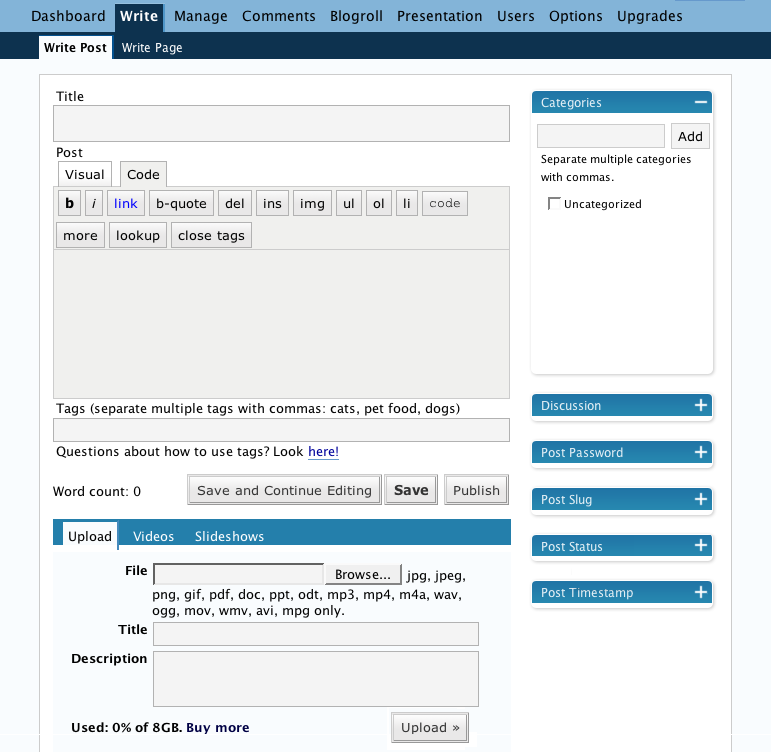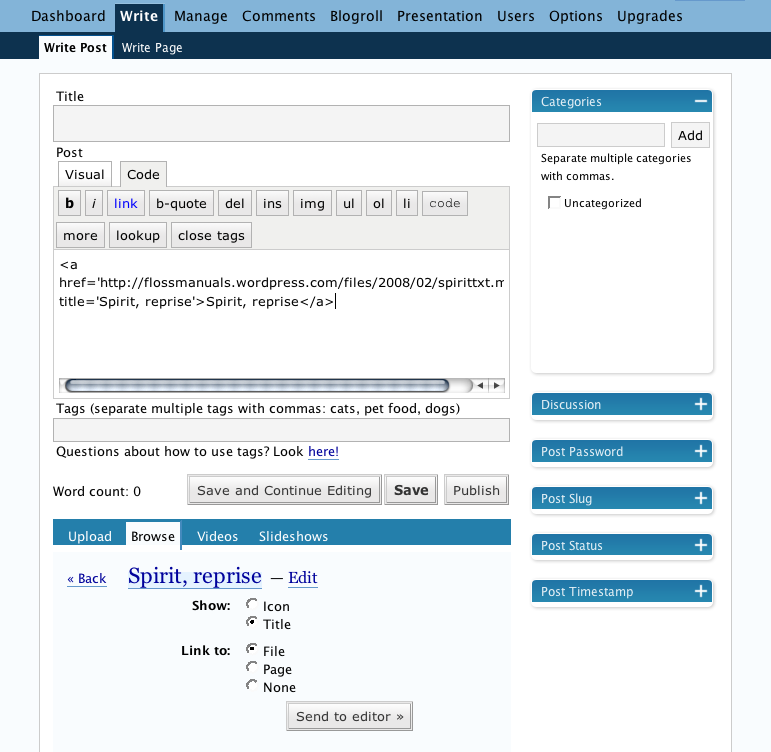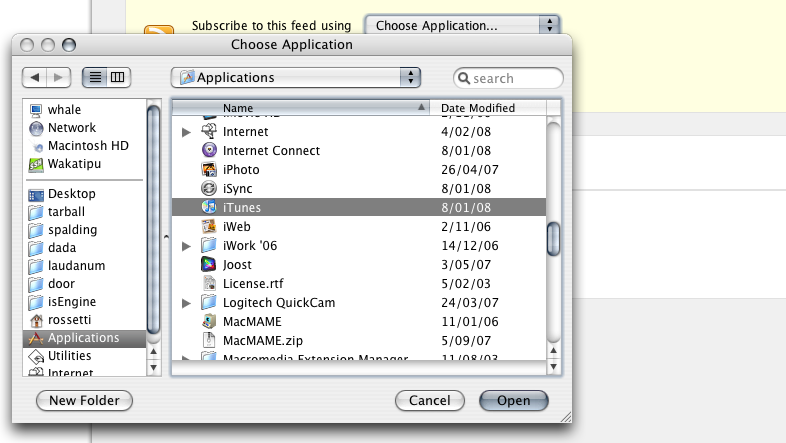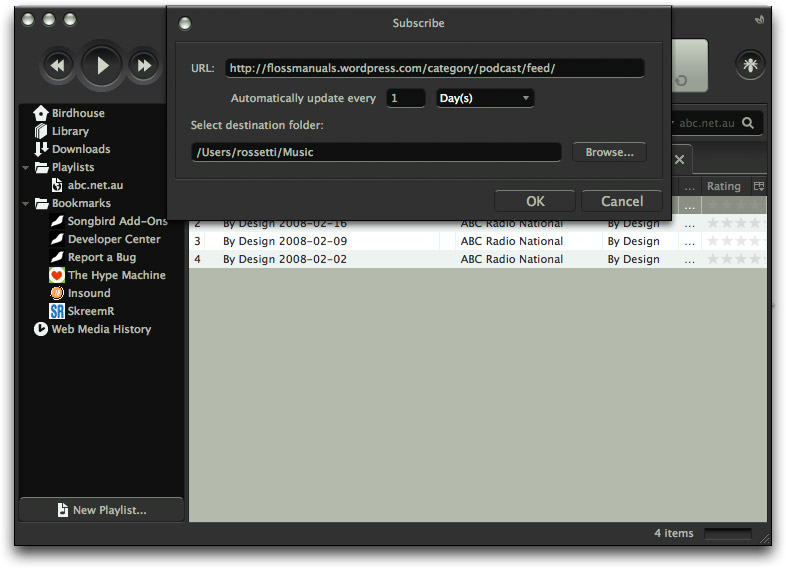Podcasting with WordPress
To proceed with podcasting using WordPress this you will need the following :
- A WordPress blog on your server or a WordPress.com blog with a "Space Upgrade" (a minimum of USD).
- Audio or video files that you wish to publish.
Create your media
First, create your media file. You can choose almost any media file but you should know that iTunes and iPods specifically support the following formats: .m4a, .mp3, .mov, .mp4, .m4v, and .pdf.
To ensure that as many people as possible can access your content it's best to use mp3 for audio. Video can be in a variety of formats though mp4 is recommended specifically for iPods. Remember podcasting is not just about iPods, most computers will be able to subscribe to podcasts and play the media files you download.
Uploading the audio file
- Login to your WordPress blog. In the example we will use the example flossmanuals blog : http://flossmanuals.wordpress.com/wp-admin/

Note: If you are using the "free" WordPress.com blog service, you will need to pay in order to upload mp3's to your site. Follow the link in the wp-admin page called "Upgrades". Click on the 'Upgrades' tab to view this.
http://flossmanuals.wordpress.com/wp-admin/paid-upgrades.php


- Create a new post using the 'Write' tab in the topbar

- Title your new podcast, and change the "Post" subsection from "Visual" to "Code" view.
- Scroll down the page until you see the "Uploads" subsection. (Video podcasting works slightly differently if you are using WordPress.com instead of your own website. See the additional notes in the "Advanced" section below.)
- Press the "Browse" button next to the File input area beneath the Uploads tab. Do not confuse the "Browse" button with the "Browse" or "Browse All" tabs.
- Locate and select the media file on your computer's system.

- Title the file in the field provided beneath.

- Press the "Upload" button at the bottom of the "Uploads" subsection. Do not confuse the "Upload" button with the "Uploads" tab.
- For some time your browser will be busy uploading the new file to the web server. Be patient and do not close the browser or press Stop, Reload or Back buttons.
- When the upload is complete, the "Uploads" subsection will automatically switch to the "Browse" tab displaying your newly uploaded file.
- From the "Browse" tab, select "Show: Title" and "Link to: File" before pressing the "Send to editor" button.
- Identify that the "Post" subsection above now contains the HTML code for a link to the mp3 file. Make sure that the link is 'absolute' and gives the full path. eg:
http://flossmanuals.wordpress.com/files/2008/02/spirittxt.mp3
not /files/2008/02/spirittxt.mp3

- Any additional text in the "Post" section of the "New Post" page will be added into the "Description" field of the podcast.
- Optionally, add the post to a podcast category in the right hand sidebar.
- Finally press the Publish button. It is located between the "Post" (or "Tags") subsection and the "Uploads" subsection. Momentarily, your Post page will be replaced with a new empty Post page, with the words "Post saved" in the top alert box.
 Adjacent to that, there is a "View post" link. Click that now.
Adjacent to that, there is a "View post" link. Click that now.
Publishing the podcast
WordPress automatically understands how to publish podcasts. It looks for a link to an mp3 within a post, and formats the RSS feed appropriately. All you need to do now is advertise the RSS feed. If you are using Firefox you will see that there is an RSS icon in the location bar.
![]()
If you are using the default WordPress template, then you will see an "Entries (RSS)" link in the footer of every page. If you click on either of those, you will see the RSS feed for your blog, including the podcast posts.
http://flossmanuals.wordpress.com/feed/
Firefox will automatically offer to subscribe you to this feed. If you have iTunes or another mp3 player installed, you may be able to use the "Subscribe to this feed using..." dialog box at the top of the page.
Testing the podcast
Either attempt to get Firefox to automatically subscribe you to your new feed, or copy the feed link and open your music player. Using iTunes, you can use the menu item Advanced > Subscribe to Podcast. Simply paste in the feed URL that you had copied earlier. Once you have done that, iTunes will connect (by default) every day to your blog and download all the new media files that you have uploaded.
- Select the Podcasts item in the Library sidebar.
- Press the reveal arrow next to the title of your blog in the Podcasts list.
- Double click on one of the files listed.

Note: To force iTunes to update the podcast listing, right click on the blog title, and select "Update Podcast" from the contextual menu.
Songbird is a cross platform open source media player based on the Mozilla platform. To subscribe to a podcast using Songbird, select the menu item File > New Subscription…. Paste in the feed URL that you had copied earlier. Once you have done that, Songbird will connect (by default) every day to your blog and download all the new audio files that you have uploaded.

Important: As of version 0.4 Songbird will fail to see any media files posted before a post that does not contain a media file. In order to work around this bug, follow the method Creating a podcasting category feed, outlined in the Advanced section below.
Advanced topics
Video podcasting using WordPress.com
There is a slight difference in the interface used on WordPress.com when you are dealing with video. Follow the steps above (1-4) until you get to 4f. The continue from here
- Uploading video
- When the upload is complete, the "Uploads" subsection will automatically switch to the "Videos" tab displaying your newly uploaded video. It will show a small still from the video, probably with the word "Transcoding" printed over the top. This means that the WordPress.com server is converting (or transcoding) the video into its preferred format.
- Click on the still image of the video you wish to podcast. You will see a small playable version of the video, and the "shortcode" for embedding the video in the post. You may add the shortcode to the post, but in order to podcast it, we need to add a proper link to the file. Click on the "Links" link on the right side of the "Videos" tab
- Copy the full absolute link from the "File:" area.
- In the "Post" section, above, type in the title of the video. Highlight the title and click on the "Link" button in the code editor. In the window that pops up, paste in the link that you copied from the video upload section below and press "OK"
- Carry on with the instructions aboe from 4h.
Creating a podcasting category feed
To advertise a feed that contains only podcasts, or a subsection of podcasts, first add each of these posts into a category of their own. For example, "Podcasts" or "Video".
- Secondly, visit your WordPress admin page and follow the topbar tabs to "Manage > Categories"http://flossmanuals.wordpress.com/wp-admin/categories.php
- Note down the category ID on the left hand side of the category that you created.
- Now visit the main Feed page of your blog. For example, at WordPress.com http://flossmanuals.wordpress.com/feed or on your own site http://wordlist.just1.name/?feed=rss2
- Now append either a query to the end of the URL (web address) or extend the query if one already exists. The format is cat=[id] For example, on WordPress.com add ?cat=[id] http://flossmanuals.wordpress.com/feed?cat=1142 or on your own server you might need to add &cat=[id] depending on your permalink settings. http://wordlist.just1.name/?feed=rss2&cat=37
- An alternate method for WordPress.com follows the following format.
http://flossmanuals.wordpress.com/category/podcast/feed/ - Now press return or enter, and check that only the required posts are displayed.
References
- WordPress podcasting documentation http://codex.wordpress.org/Podcasting
- iTunes podcasting technical specifications http://www.apple.com/itunes/store/podcaststechspecs.html






